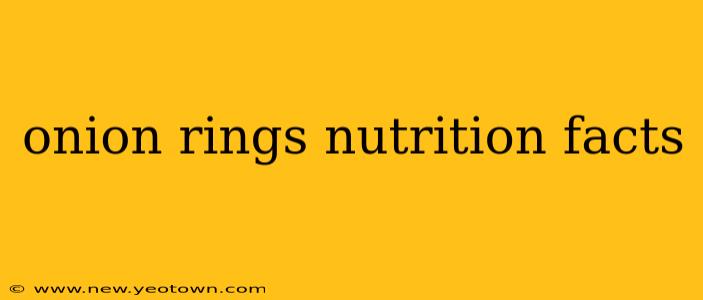Ah, onion rings. The crispy, golden-brown delight that often steals the show alongside burgers and fries. But before you dive headfirst into a mountain of these tempting treats, let's take a closer look at the onion ring nutrition facts. Understanding the nutritional profile can help you make informed choices and enjoy this guilty pleasure without excessive guilt. This isn't about deprivation; it's about mindful indulgence.
What are the calories in onion rings?
The calorie count in onion rings varies wildly depending on the size of the rings, the breading style (thick, thin, battered), the type of oil used for frying, and even the serving size. A typical serving of about 10 medium-sized onion rings can contain anywhere from 200 to 300 calories or even more. Those extra-large, thickly battered beauties? They can easily pack over 400 calories per serving. It's a caloric rollercoaster, isn't it?
How many carbs are in onion rings?
Carbohydrates are another significant component of onion ring nutrition. The carbs primarily come from the flour used in the breading and the onion itself. A serving of onion rings can range from 25 to 40 grams of carbohydrates, depending on the factors mentioned above. Remember that simple carbohydrates are digested quickly, leading to a rapid spike in blood sugar levels.
What about the fat content in onion rings?
The fat content is often the biggest nutritional concern with onion rings. They're deep-fried, after all! The type of oil used plays a significant role here. A serving can have anywhere from 10 to 20 grams of fat, and a substantial portion of this will be unhealthy saturated and trans fats if fried in less healthy oils. Opting for healthier cooking methods like baking or air frying can dramatically reduce this fat content.
Are onion rings high in sodium?
Yes, onion rings are often high in sodium. The breading often contains salt, and they're frequently seasoned with additional salt after frying. Excessive sodium intake is linked to high blood pressure and other health problems. Checking the nutritional information on restaurant menus or packaged products is crucial to monitor sodium levels.
Are there healthier ways to make onion rings?
Absolutely! While deep-frying is the traditional method, baking or air frying provides a healthier alternative. Baking onion rings reduces the fat content significantly, and air frying gives you that satisfying crispy texture with less oil. You can also experiment with different breading options, such as using whole-wheat flour or adding oats for added fiber.
What are the benefits of eating onions?
While the deep-fried, breaded version isn't exactly a health food powerhouse, let's not forget the base ingredient: onions! Onions are packed with antioxidants, and various studies suggest they may offer benefits for heart health and even have anti-inflammatory properties. However, these benefits are most pronounced when consuming onions in their whole, unprocessed form.
How many onion rings should I eat?
Moderation is key! Given the calorie, fat, and sodium content, it's best to treat onion rings as an occasional indulgence rather than a regular part of your diet. A small portion as part of a larger, balanced meal is a wiser choice than making onion rings the centerpiece of your plate.
Can I make homemade onion rings that are healthier?
Yes! Making your onion rings at home allows you to control the ingredients and cooking method. Using healthier oils, reducing the amount of breading, and opting for baking or air frying will drastically improve the nutritional profile compared to restaurant versions. Experiment with different breading combinations – you might find a healthier, yet still delicious, recipe!
Remember, informed choices lead to mindful indulgence. By understanding the onion ring nutrition facts, you can enjoy these crispy treats without sacrificing your health goals entirely. Enjoy in moderation, and savor every bite!

